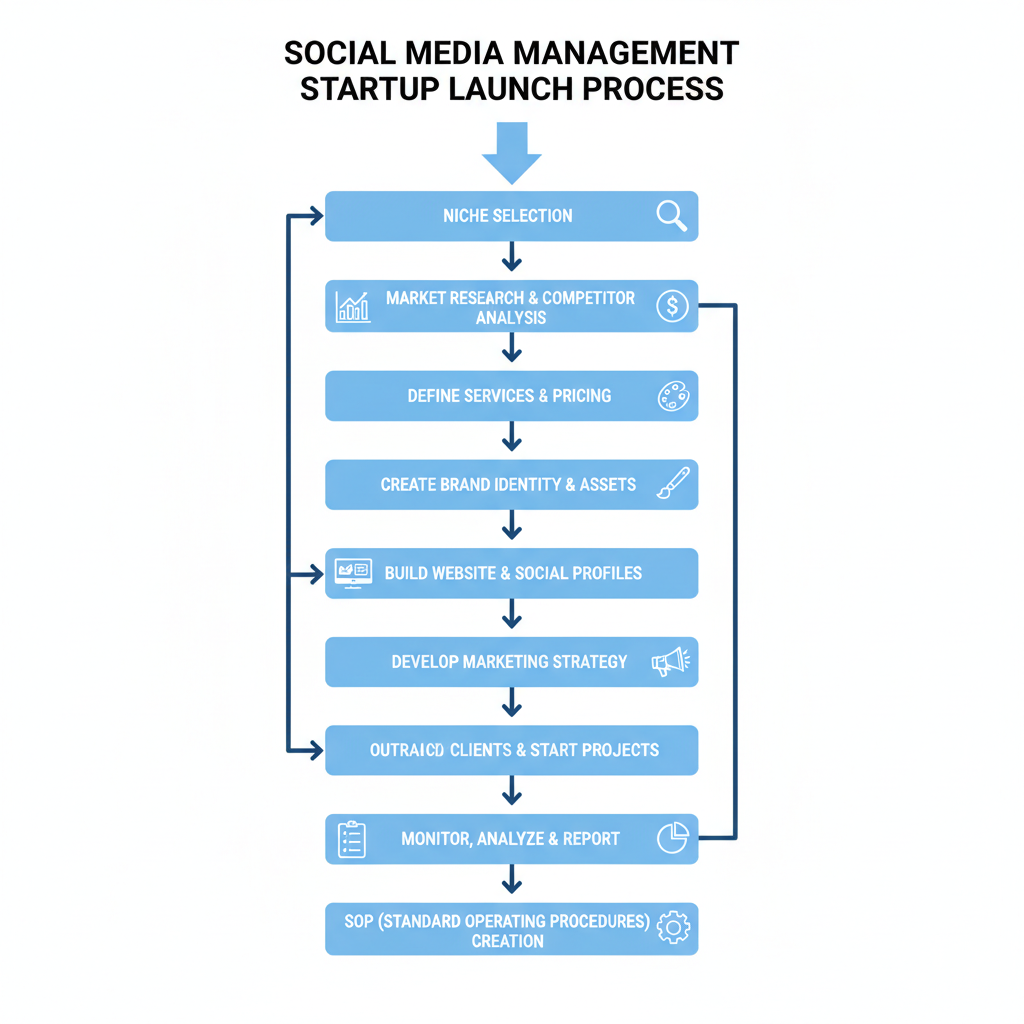How to Launch a Social Media Management Startup
Learn how to start a social media management business with niche targeting, competitor research, smart pricing, and a strong online presence.

How to Launch a Social Media Management Startup
If you’re ready to break into the rapidly growing digital marketing world, learning how to launch a social media management startup can be your ticket to a rewarding and profitable business. With brands increasingly reliant on online engagement to attract and retain customers, there’s never been a better time to position yourself as a trusted expert. This comprehensive guide will walk you step by step through identifying your niche, building your brand, attracting clients, and scaling your social media management business.

---
Identify Your Niche Market and Target Industries
Before investing time and resources, define a clear niche. Social media is vast, and honing in on a specific area of expertise will give you a competitive edge and a recognizable brand identity.
- Industry focus: Tech startups, restaurants, e‑commerce, non‑profits
- Platform specializations: Instagram marketing, LinkedIn personal branding, TikTok short‑form video
- Audience type: B2B vs. B2C
A targeted focus builds credibility faster and allows you to deliver highly tailored strategies that outperform generic competitors.
---
Research Competitor Agencies and Service Offerings
Your competition can be one of your best teachers. Conduct a thorough analysis of other agencies to understand:
- Pricing ranges
- Services offered (posting frequency, ad management, influencer outreach)
- Marketing style, personality, and brand voice

Competitive analysis tips:
- Follow their social accounts to study engagement tactics.
- Subscribe to newsletters to analyze lead‑nurturing strategies.
- Review LinkedIn profiles of their staff to see operational structures.
---
Define Your Unique Value Proposition (UVP) and Brand Positioning
Your unique value proposition answers: “Why should clients choose you over anyone else?”
- Example UVP: “We help sustainable fashion brands grow Instagram engagement by 150% in 90 days.”
- Positioning can emphasize speed, specialized skills, measurable results, or creative storytelling.
Document your tone of voice, core messaging pillars, and brand promise before approaching potential clients.
---
Choose Pricing Models Wisely
Pricing affects both client relationships and profitability. Common models include:
| Model | Description | Pros | Cons |
|---|---|---|---|
| Monthly Retainer | Fixed monthly fee for agreed services | Predictable income | Requires consistent workload |
| Service Packages | Bundled services at a set price | Easy to sell | Limited flexibility |
| À la Carte | Individual service selection | Customizable for client | Harder to forecast income |
Limit offerings to 2–3 clear options to simplify decision‑making for prospects.
---
Build a Professional Online Presence
Your potential clients will evaluate you online before starting a conversation. Make sure you have:
- Website: Professional, mobile‑friendly, and fast‑loading
- Portfolio: Showcasing real or mock‑up work
- Case Studies: Before‑and‑after examples demonstrating measurable results

Include relevant, keyword‑optimized blog content to attract organic traffic from search engines.
---
Set Up Essential Tools for Productivity
The right tech stack makes daily operations more efficient.
- Scheduling tools: Buffer, Hootsuite, Later
- Analytics tools: Google Analytics, native platform insights
- Design software: Canva, Adobe Creative Cloud
Integrate your tools where possible—for example, connect scheduling software with design applications.
---
Create Standard Operating Procedures (SOPs)
SOPs help ensure consistent quality. Develop clear processes for:
- Content creation – Idea generation, asset design, copywriting
- Approvals – Client feedback before publishing
- Reporting – Monthly analytics plus recommendations
Collaborate in the cloud using tools like Google Drive, Notion, or ClickUp.
---
Develop a Strategic Marketing Plan
To secure clients, create a diversified marketing approach:
- SEO: Target relevant keywords like “social media management startup”
- Social proof: Share testimonials, reviews, and case studies
- Networking: Attend trade shows, webinars, and local meet‑ups
Pair content marketing with personalized outreach for best results.
---
Leverage LinkedIn and Industry Groups to Source Clients
LinkedIn is a goldmine for B2B outreach:
- Join groups in your target industry
- Post thought‑leadership content weekly
- Engage in conversations—offering value without hard selling
Also explore Facebook and Slack communities for specialized networking.
---
Create Sample Campaigns to Win Leads
If you don’t have client examples yet, create mock campaigns:
- For a cafe, design a 30‑day Instagram calendar with images, captions, and hashtags
- Include hypothetical performance data to illustrate potential ROI
Use these as lead magnets in exchange for email subscriptions.
---
Onboard Clients with Clarity
Establish expectations early:
- Kickoff meeting – Discuss brand identity, goals, and audience
- Agreement & scope – Include deliverables, timelines, and communication channels
- First‑month roadmap – Share deliverables schedule and reporting plan
Clear frameworks improve retention.
---
Measure KPIs and Optimize Regularly
Track meaningful metrics such as:
- Engagement rate
- Follower growth
- Click‑through rate (CTR)
- Conversions from ads
Review results monthly and adjust strategies to maximize ROI.
---
Scale Through Outsourcing, Hiring, or Specialization
When ready to grow:
- Outsource creative work, ad management, or copywriting
- Hire full‑time staff for ongoing workload
- Specialize further with influencer marketing or advanced paid media
Project management tools will keep expanding teams aligned.
---
Stay Ahead of Platform Updates and Trends
The social media landscape evolves quickly. Keep skills current through:
- Official platform announcements and blogs
- Industry newsletters
- Online courses, webinars, and conferences
Adapt client tactics promptly when algorithm changes occur.
---
Summary and Next Steps
Starting a social media management startup requires strategic focus, a compelling brand, the right tools, and consistent performance optimization. By specializing in a niche, showcasing measurable results, and networking effectively, you can quickly establish credibility and attract high‑quality clients. Keep refining your processes and staying ahead of industry changes to sustain long‑term growth.
Ready to get started? Draft your niche statement today and begin building the digital presence that will attract your first wave of clients.



